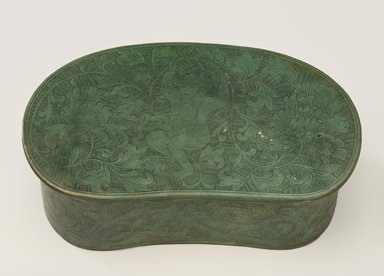
Medium: Stoneware with slip and lead glaze
Geograhical Locations:
Dates:960–1279 C.E.
Dimensions: 5 1/2 x 14 3/4 x 8 5/8 in. (14.0 x 37.5 x 21.9 cm)
Collections:
Museum Location: Asian Galleries, West, 2nd floor (China)
Exhibitions:
Accession Number: 2001.6.2
Image: 2001.6.2_top_PS9.jpg,
Catalogue Description: Bean-shaped pillow with incised and shallowly carved surface decoration on the center and sides surfaces. An infant boy with his arms raised above his head and clutching a flowering peony vine is the central motif of the pillow. Set against a background of faintly incised striations, the figure is flanked by two flowering peonies. A meandering leaf pattern decorates the sides and is also set against a striated background. A green glaze covers the surface except at the base. The image of an infant boy grasping peony flowers was a design motif on ceramics and textiles during the Northern Song dynasty (960-1127). The motif of male children associated with flowers symbolizes good fortune and the wish for male progeny for many successive generations. The inclusion of the peony flower in these images is less common than the representation of lotus flowers since the depiction of children grasping lotuses expresses the auspicious sentiment directly - the Chinese character for lotus, lian, is a homonym of the Chinese character for succession. It is also believed that the motif of young boys afloat with flowers was initially Indian in origin and reached China with the inception of Buddhism but held meaning to the Chinese in a way unrelated to Buddhism. On pillows, the images of male children surrounded with flowers functioned in one sense to inspire the production of many male offspring.